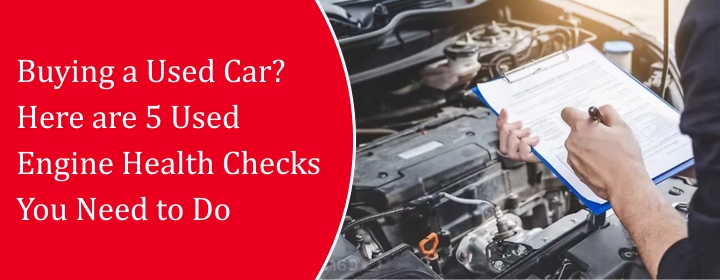
Buying a Used Car? Here are 5 Used Engine Health Checks You Need to Do
When buying a used car, one should consider the adage ‘Looks Can Be Deceiving. A car that looks good on the outside can have major issues on the inside, especially the engine. The trick is in knowing how exactly you can inspect the car in question.
Inspection can range from any mechanical part, like an engine or transmission, to something electrical, like an ECU. A vehicle is a complicated machine that works on a multitude of small machines. Buying a used car can mean one of two things. Either you are on a budget, or you are buying to polish your driving skills. Still, it is a big investment; this guide will let you know the essentials for making a fruitful investment.
Necessary Checks:
- Review Maintenance Records
- Condition of Part-Pistons, Cylinder Heads, etc.
- Physical Signs of Wear
- Engine Sound
- Working of the Exhaust
Review Maintenance Records
When buying a used car, always ask for the service records. If the maintenance is recorded effectively, it will tell you everything about this car. Check for:
- Any Tune-ups
- Times the Oil has been changed
- Any Major Repair
- If the car has been a part of an accident
If the document shows any irregular gap in maintenance, it means the engine was neglected. Consistent maintenance often means better engine performance. These records give a true picture of the used car’s health. If there are frequent repairs or part replacements listed, dig deeper before finalizing. Records should show professional work and not just quick fixes. Clean paperwork adds confidence when dealing with a used engine. This step helps you avoid surprises after the purchase. It also proves the seller took care of the vehicle.
Condition of Part—Pistons, Cylinder Heads, etc.
The internal parts of a used engine can reveal a lot. Check if the pistons and cylinder heads are in good shape. If allowed, have a mechanic open up the engine. Look for cracks, burns, or any oil sludge. These signs can mean deep internal wear. If the engine has been used properly, there would not be any signs of damage. Damaged piston rings and warped cylinders are a clear sign of overheating. Which could only mean one thing: the engine was pushed too hard, regularly.
Before buying a used car, make sure the engine doesn’t have such signs. Otherwise, the money you have saved could be spent on parts replacements. And if the engine is beyond repair, you may have to buy a used engine. Make sure all core parts are undamaged.
Physical Signs of Wear
You can learn a lot just by looking at the engine. A used engine should not have leaks or loose wires. Look at the hoses, belts, and mounts. Cracks or wear on these parts show aging or poor upkeep. Check the oil cap for any white substance, which may suggest coolant mixing with oil. Rust around the engine bay is also a red flag.
Cleanliness matters too. A clean engine means it has been maintained. While a dirty one might hide deeper problems. These signs are simple but effective in judging a used car. When you see visible wear, it means you might spend more later. Always look closely before buying.
Engine Sound
After starting the car, let it run on idle. The sound of a healthy engine can be recognized easily. If there are no unusual ticking or knocking sounds, the engine is good. Pay attention to how it idles. The sound should stay steady. Any sudden jerks or misfires may suggest problems inside the engine. Revise it lightly and listen to how it responds. If there is hesitation or roughness, it could mean poor compression or bad fuel flow. The sound coming from a used car’s engine is often the first warning sign. If it does not sound right, trust your ears. Strange sounds almost always mean repair work ahead. Always test this before finalizing your decision.
Working of the Exhaust
The exhaust tells you about the engine’s inner health. When buying a used car, check for smoke from the tailpipe. Blue smoke means oil burning. White smoke may suggest a head gasket leak. Black smoke shows that too much fuel is burning. A clean exhaust with no visible smoke is a good sign. Listen to the sound, too. It should not be loud or uneven. Also, check if the exhaust smells like burnt oil or fuel. These signs often connect to engine issues. A proper exhaust check gives clear insight into the condition of the used engine. Never skip this step during your inspection.
Conclusion
When purchasing a used car, you may have numerous thoughts and considerations to keep in mind. Make sure that you have checked the used car engine properly. Regardless of the quality of the engine, a healthy engine is essential for a successful transaction.